Last Updated: January 19, 2020
Back: Atlantic overview
Skip to: every title mono
Skip to: every title stereo
Guide to the labels of Atlantic
at-a-glance
The Atlantic jazz catalogue was more limited than the specialist jazz labels – Mingus, Coltrane (briefly), and Ornette. Full wiki discography of Atlantic 1200 – 1700 jazz series.
Atlantic recordings were licensed for UK release through Decca’s London label, so US Atlantic originals are not something seen very often in UK.
US Pressing plants used by Atlantic
Unlike many of the major labels, Atlantic assets did not extend to ownership of their own pressing facilities, but used a large number of independent plants around the US, for metal parts manufacture and pressing Atlantic titles. Process control was achieved by adding a plant code to the matrix code.
AR: Allied Record Company; Los Angeles, California
PL: Plastic Products; Memphis, Tennessee
BW: Bestway Products; Mountainside, New Jersey
PR: Presswell Company; Ancora, New Jersey
CL: Columbia
RI: PRC .; Richmond Indiana
CP or no code: Columbia; Pitman, New Jersey
SP: Specialty Records Corp.; Olyphant: Pennsylvania
CT-CTH: Columbia; Terra Haute, Indiana
WM: Midwest Record Pressings; Chicago, Illinois
LY: Shelley Products; Huntington Station, New York
MO: Monarch Records; Los Angeles, California
Info from 45 sleeves
The labels
1.1 1955-59 Black Label, mono

The “anvil-like” symbol after the matrix indicated the pressing plant (not known to me) ; right, the stamper identifier code, AT on one side, AT1 on the other.
1.2 Stereo
Picture: Discogs
2. 1959-60 Orange/Plum wheel and fan, DG, Mono
2.1 Green/Blue wheel and fan US (stereo)
Photo courtesy of Tim
3. Atlantic White Fan (1960-62)
3.1 Orange / Plum, White Fan, Mono
Early titles – no registered trademark above fan
Later titles – with registered trademark above fan.
3.2 Blue / Green White Fan, Stereo US DG
Early example – no registered trademark symbol
4. Atlantic Black Fan 1962-66
4.1 Mono – Orange/ Plum, Black Fan
4.1 Stereo – Green/Blue Black Fan
This Stereo variation is so-called “logo-box” – the name “Atlantic” and symbol “A” together with the fan are contained all together in a box. This appears quite different from the mono, so its exact place in labelography is not known, but it is later design, possibly the 1966-8 predecessor to the eponymous Green/ Orange (1968+)
1967 pressing with busy runout. W – 3 dots above 1 below (Audiodisk blank acetate) STERLING Sterling Sound Studios; RL – Robert Ludwig mastering engineer; AT Atlantic client , obviously
The following year, in October 1967, Atlantic was sold to Warner Bros.-Seven Arts, later Warner Communications (whose name appears on the label after 1975) who’s talents were in distribution and marketing and displayed little understanding of vinyl quality production, assisting its terminal decline as a source of recorded music.
5. 1968-73 Green/Orange, 1841 Broadway NY address, Stereo
6. Mid 70’s Green / Orange, 75 Rockerfeller Plaza address with Warner Communications logo.
The green/orange label, “A Warner Communications Company” and disappointing audio quality from here on. In some cases the only way to own it on vinyl, though CD will provide an equivalent audio experience. Below, the1981 release of previously unreleased Tristano/Konitz live Sing Song Room of The Confucius Restaurant NYC sessions. Despite best efforts to restore these iconic sessions the vinyl still lacks the presence you would normally find on late Fifties / early Sixties vinyl.
Next: Atlantic in UK/Europe
..

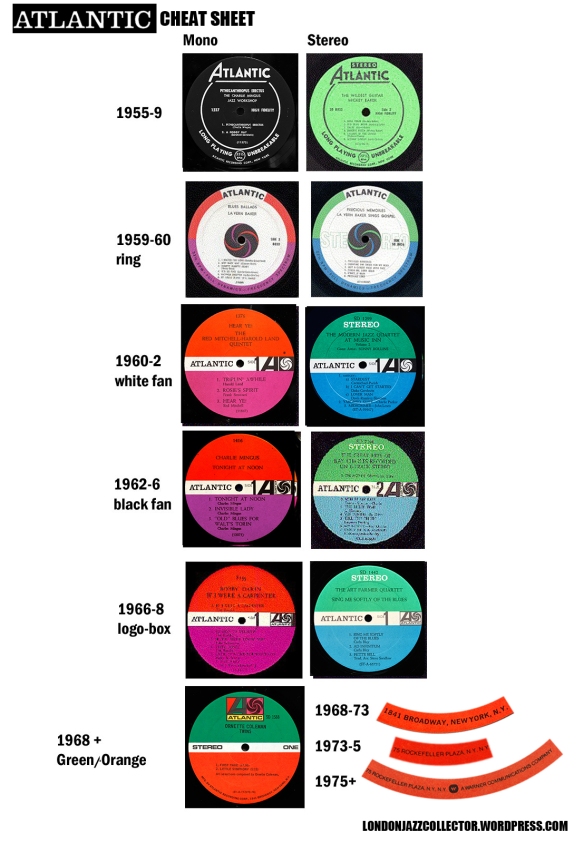
![c800-Black-Original-6000857265_602918a675_o[1]---Copy](https://londonjazzcollector.files.wordpress.com/2011/12/c800-black-original-6000857265_602918a675_o1-copy.jpg?w=584&h=581)
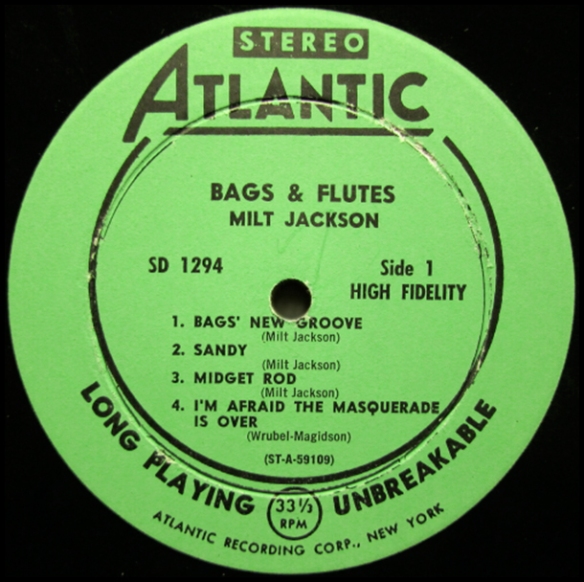


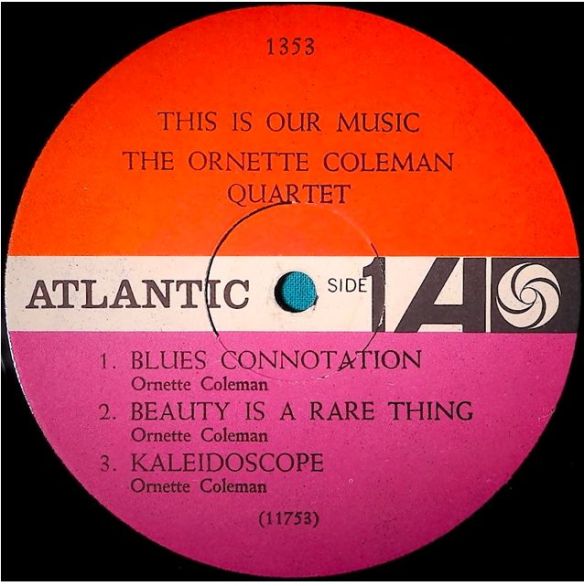


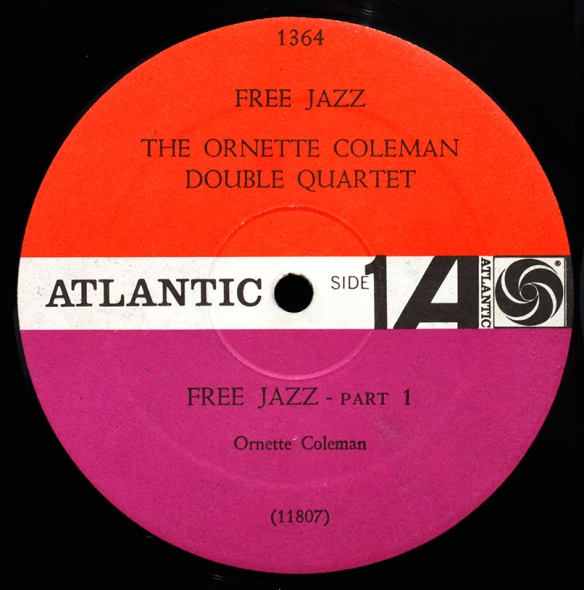



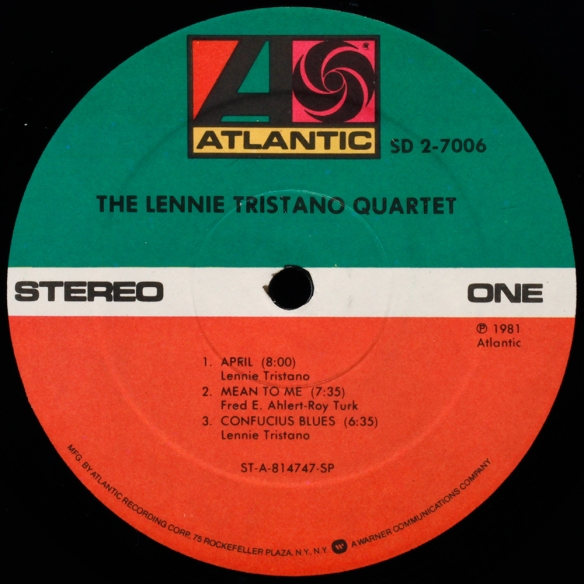
I just found a copy of Mingus’s ‘Oh Yeah’, the back cover says ‘Printed in the USA’ with a date of 1965. I see no ’65 copies on Discogs. What’s more the labels are the earlier back style. There is a ‘D.R.’ On both sides too…stumped.
LikeLike
Photos? cover and labels? Without seeing what clues there are, who knows. Please email me jpg’s or links.
LikeLike
This is an exciting find. Please add it to the Discogs database for all to see.
LikeLike
Hi Andy,
about Atlantic mono pressing or stereo pressing, which do you think sounds better about The Modern Jazz Quartet ” Pyramid ” album ?
Many thanks !!!!
Paola
LikeLike
Since I have not heard either edition, I can’t vouch for either from experience. But driving blind, if I had to choose, I would probably opt for the Stereo. Why? Most of recordings were made at a good modern studio – Capitol Studios, NY, which will have had top equipment and the engineer on some though not all was Tom Dowd, who is a solid performer. By early 1960 stereo was well established, and if I’m right, Atlantic was the first major label to drop mono altogether and issue new titles only in stereo. Other Atlantic titles I have in stereo are good recordings. Unless you have a strong mono leaning (mono cart etc) personally I would plump for stereo.
LikeLike
Thanks a lot Andy for your opinion. I was curious because I have this stereo pressing ( https://www.discogs.com/release/5957838-The-Modern-Jazz-Quartet-Pyramid ) but I’m not very satisfied about sounds quality. The sound is rather flat and lacks of bass !!!!
LikeLike
I’ve had both the original black label mono and green label stereo pressing of The Modern Jazz Quartet “Pyramid” and the stereo wins hands down for this title.
LikeLike
Thanks a lot Aron for your opinion. I was curious because I have this stereo pressing ( https://www.discogs.com/release/5957838-The-Modern-Jazz-Quartet-Pyramid ) but I’m not very satisfied about sounds quality. The sound is rather flat and lacks of bass !!!! Probably the green label first pressing is much better than mine.
LikeLike
Thanks a lot Aron for your opinion. I was curious because I have this stereo pressing ( https://www.discogs.com/release/5957838-The-Modern-Jazz-Quartet-Pyramid ) but I’m not very satisfied about sounds quality. The sound is rather flat and lacks of bass !!!! Probably the green label first pressing is much better then mine.
LikeLike
Hello LJC,
I have a black label Atlantic-1224 Lenny Tristano. I don’t believe it is deep groove. How would I know if it is? Is there a DG stamped into the dead wax runout groove? I don’t know what year this was pressed but it does have an Atlantic inner sleeve with a catalogue of LPs released as late as 1959 and 1960. Were deep grooves only on the first pressings or did subsequent re-issues also have it?
LikeLike
I don’t know the pressing history of every Atlantic title, but 1224 is pictured in my mono Atlantic pressing label guide here –
First press is unambiguously deep groove in the outer label area, like all the titles pressed around that number
Non-DG dies first began to appear in late 1961, and overlapped in transition until as late as 1965, depending on pressing plant (for Blue Note certainly, others, who knows?)
To be more definitive, a picture of the runout and label would be more helpful. There are often visual clues not identified in verbal descriptions.
LikeLike
Dear LJC, now listening to newly acquired ‘Coltrane’s Sound’ SD 1419 Green/Orange, 1841 Broadway NY address record.. 🙂 ..where Discogs tells me it’s a 1966 release! (Matrix / Runout (Label matrix, side A): ST-A-64533-SP).. Did I miss something? How strict is your 1968 starting point for this label design??
Kind regards,
LikeLike
Dear LJC,
I am looking for coltranes’ my favorite thing. I heared some people prefer the 70s’ pressing cut by Piros (GP). I found a several pressing that I interested:
1. 1975 with ’75 Rockefeller Plaza’ address and ‘Warner Communications’ on label, but 1841 Broadway address on sleeve.
2. 1974 with ’75 Rockefeller Plaza’ address and no ‘Warner Communications’ .
3. 1973 with “75 Rockefeller Plaza” address on the A-side and “1841 Broadway” address on the B-side.
4. 1966 with green/blue labels, black fan and “Atlantic” written horizontally.
Which one would you prefer? I am struggling with these pressings.
LikeLike
Dear LJC,
I read your blogs with great interest and now I happen to have an Atlantic Records question..
A year ago or so I bought Mingus’ Pithecanthropus Erectus.. Looks like some Atlantic repress, but has few indications which one. No.1237 (11374) on the label, that is made to look like the red/purple ring lable, but says ‘STEREO’ on the left side.. I suppose it’s just some recent issue, but then: which one?
LikeLike
It’s probably this one: https://www.discogs.com/The-Charlie-Mingus-Jazz-Workshop-Pithecanthropus-Erectus/release/1205196
LikeLike
Aaron, I think you’re right!! 180gr feels believable.. ..the somewhat fake nostalgic label would probably fit such a 2001 reissue. And the numbers fit: (Discogs) “Matrix / Runout (Side A, label): 11373 | Matrix / Runout (Side B, label): 11374”
Thanks!
LikeLike
The original mono 1st press is Atlantic black label – here
1956 original issue, Was there a stereo issue at that time? It was not until around 1958 that the single stylus microgroove system became industry standard. It’s a bit of a stretch but possibly, or maybe the bullseye was the 1st stereo issue?
LikeLike
Thanks for your reply! From what I understand from your labels overview, older stereo issues would have had the green circle, not the purple one.. So whoever reused the circle for my LP must’ve done that for nostalgic reasons in the first place and not for historical accuracy.. And Aaron in the comment above probably found my version!
Regarding the music (never listened to Pithecanthropus before), I can hardly believe it’s from ’56.. ..I know Tijuana Moods and Ah-um by heart for a long time and only yesterday realised they’re from the same years.. It’s so fresh and urgent, so much advanced to what was done at the time.
LikeLike
1237 was only recorded in mono. In the fifties it was listed by Atlantic as ‘mono only’.
LikeLike
Thanks Rudolf. That implies that they somehow ‘stereo’d’ the record for later issues..
LikeLike
My copy of Pithecanthropus Erectus is this black/silver mono label but it has the large deep groove pressing ring which is different from this version pictured here with the smaller pressing ring around the spindle hole. Certainly these were pressed at different plants, likely to make regional distribution more efficient and cost effective. How do we know for certain which is truly a “first press” if the same label exists in deep groove large outer pressing ring, non-deep groove large outer pressing ring and non-deep groove small pressing ring around spindle hole? Just a question that I haven’t felt has been truly answered properly.
LikeLike
First pressing is clear with small independent labels who pressed in limited quantity a new release in just one run, at just one plant , like early Blue Note. When majors like Columbia, Atlantic, and Liberty enter the scene, using multiple plants, and sometimes contracted out pressing, first pressing die marks may differ. Atlantic did not own any pressing plants, as Columbia did, and are known to have used at least a dozen different plants in those years. I’m not certain in this case, it is not well documented.
LikeLike
The green/orange label, “A Warner Communications Company” and disappointing audio quality from here on.. hi again will it be the same case for the green/orange label with the broadway address too? thanks LJC
LikeLike
1968-73: passing through the transitional years, and engineers with different ideas how things should sound, on thinner vinyl. New issues on this label have a fair chance of being OK, but reissues are generally disappointing, based on limited experience, of course. Unless I have a specific reason, I tend to avoid them.
LikeLike
thank you for your kind reply LJC
LikeLike
hi LJC. first of all. I really treasure all the info and painstaking research and effort you have carried out. just love the label guidance. really useful to collect jazz LPs, esp those that you adore. just need to ask, is it fair to say that the 1968 blue green label vs a 1962 blue green white wont make much of a sonic difference? im aiming for Coltrane/bags LP. and noticed that the first 2 stereo US issues were done in 62 and 68. hmmmm
LikeLike
If condition was the same – that is a big if, – I would prefer the earlier 1962 edition. Six years extra wear from heavier tone-arms, but heavier vinyl, often deeper groove cut and oddly, louder. A second issue may be re-mastered and not pressed from the original metal, though I have no special knowledge regarding this title. .Lots of reasons to favour the earliest edition. I have to caution regarding early stereo. Recordings from late ’50s/very early ’60s, mono is often preferred, due to the hard-panning of the stereo mix. It makes some recordings quite hard to listen to, but that is a personal thing.
LikeLike
thanks so much for your response. I truly appreciate it LJC. ive ordered the ’66 (sorry shld be ’66 not 68 as written in my prev post) press of bags & trane and ill write again once ive spun it on my ttable. thanks so much for doing all this. you’ve inspired me to go for the originals where possible n affordable 😀
LikeLike
https://www.discogs.com/Milt-Jackson-John-Coltrane-Bags-Trane/release/722772 its this one 😀
LikeLike
on your 45’s (yellow or red label); does the fan mean it is a re-issue?
LikeLike
I have the same question as regards 45rpm labels. Have a Ray Charles 45 that looks like the original 1959 release except for the presence of that fan logo on the left (with an ® next to it). Would like to be able to date it.
LikeLike
The registered trademark ® appears on Atlantic label for the first time in 1961/2, so that opens the window on dating. A lot of records went on to multiple repressings so you have to follow things like cover detail, logo design, cover addresses, to narrow it down further. I’m afraid you need to sweat the data yourself, no simple answers.
LikeLike
Are the “1841 Broadway” Orange &a green labels recommended?
LikeLike
Obviously dependent on the original recording quality (If that’s crap you are snookered anyway) from the few I have listened to, new releases on Orange Green 1841 Broadway, yes.
My reservation is when it comes to reissues of earlier released titles. Your best option is always going to be the original release label (plum/orange and blue/green are generally pretty feisty)
The green/orange reissue will almost certainly have been re-mastered for reissue (no original metal) a hostage to what the engineer liked, and tapes copied / aged. I’ve heard a few horrors, and some that have borne up remarkably well, so the label is not itself the guarantee of quality. But they are cheap, no big deal if its not so good.
LikeLike
I’m looking at picking up John Coltrane’s “Plays The Blues.”the “1841 label.” I LOVE this website! Thanks for all the information here. I’ve been using it as guide to find great sounding records! I just picked up “A Day In The City, Six Varitations On A Theme, The Don Friedman Trio.” I’m researching the label now!
LikeLike
The Ornette Coleman “Art of the Improvisors” label you’re showing is a UK print – UK Atlantic always starts with a K, US prints are SD.
LikeLike
Improvisers
LikeLike
Content beats spelling and punctuation every time, the need for correction is mine.
I’ve never been happy with that grey/orange variation. If it doesn’t tell us anything about the transition of original labels, it’s toast. Thank you.
LikeLike
Hi LJC,
I have several questions concerning the Orange / Plum White fan labels (60-62):
– I think the early ones didn’t have the “R” in the Orange part, do you know until when?
– Do you know when are the transitions (category catalogue) between Orange / Plum White fan and Black fan labels and between Orange / Plum Black fan and Orange / Plum logo-box labels?
– I am looking for Ornette Coleman “This is our Music” original mono pressing. What should the label look like? Ring or White fan? With an “R” or not, etc?
Thanks in advance for your answers,
Antoine
LikeLike
Hi Antoine
Atlantic hasn’t been given as much attention as Blue Note Impulse and Riverside, but we need to put that right and I will do it.
The broad lie of the land with jazz releases are the transitions between the labels, and something I hadn’t noticed until you pointed it out, the Registered trademark “R” which appears on the last of the Plum/Orange White Fan label around 1961, before the transition to the Plum/Orange Black Fan label
The transitions by catalogue number look roughly as follows, Mono First Pressings should be
Atlantic 1200 series, titles up to 1332 should be Black Label.
At somewhere between 1332 and 1338, The Plum/Orange White Fan label is introduced, with no R; 1375 looks like the last White Fan without R
1376 – 1381 are the last White Fan titles and these now carry the R on the label positioned above the logo-box on the general label area
Around 1382 the Plum/Orange Black Fan is introduced and these all carry the Registered Trademark, initially on the label, then built into the logo-box top right hand corner. This label runs until around 1968, with small changes in the logo-box design.
Within this framework, Atlantic 1353 Ornette Coleman This is Our Music, original first mono pressing should be Plum/Orange White Fan, no R
More research required as regards stereo, and exact transition points , but the full Monty with pictures will be added to the Atlantic Label Guide soon.
LikeLike
one more challenge: Atlantic is schizophrenic about deep groove…
LikeLike
Somewhere I’ve read that it depends on where the record has been pressed. DG was West Coast, no DG was East Coast. But that’s just sth I read somewhere.
LikeLike
volunteer wanted for Back to the Future in jazz collecting mysteries.
LikeLike
This might be where you read it:
http://olivier.landemaine.free.fr/vu/discog/lps/usa/lpsusa.html
LikeLike
Very useful, as usual! Thanks LJC!
LikeLike
Thanks for recognizing Atlantic records! Should you want more help with your early Atlantic discography? I have been collecting US Atlantic pressings for years and am only a few records shy of having all of the mono, stereo and wlp pressings from the 1200-1500 series. Working on the 8000 series now. I would love to compare notes, share photos, fact check, etc…
It seems they did not start issuing promo pressing until sometime after 1360?
Does anyone have any white label promos pre 1360?
Anyone have any info about
1315 – Perpetual Emotion – Erroll Garner [1959?] that was unreleased?
LikeLike
Hi, there are still a few gaps in the Atlantic Reference Guides to all mono and stereo titles, where a decent label shot could not be found. You may have them.
Welcome any additions, corrections, replacements.
LikeLike
LJC,
Congratulations on the amazing work you have done so far!
I can definitely add/replace most of what you have in mono and stereo, I would also suggest the start of a promo only page as well. During this process I am sure we will uncover some corrections. As you know it will take some time for me to photograph my collection. I was figuring I could also do both sides of the covers in the process if you would like to make a page solely for covers. I have found discrepancy’s and variations in the covers as well.
What would be the best way to send photos?
I look forward to contributing!
Cheers 🙂
LikeLike
spinalflow: your offer is exciting and promising. I also noted cover variations. More slippery even is the question of inners which changed in the process (red, violet, red again, green etc.)
I hope the infatiguable LJC finds the time to process the info you are going to supply.
LikeLike
I agree the inner sleeve’s are another story. It seems that most of the 1200 series came in a wax paper sleeve before the arrival of the colored white print. I have noticed a trend in which the red,violet inner sleeves seem to be found with the mono’s where as the blue and green sleeves tend to be with the stereos. I am always buying these records used so I can’t be sure an inner sleeve was not switched or replaced. I may have to open a few of the still sealed records I have in this collection to help reveal a bit more of that mystery….
LikeLike
true, a used record can be found in any inner sleeve. But very often they are sold with matching inners. One’s has got to have luck. The wax paper for the earlier ones, up to 1295 at least.
LikeLike
An elite collector, excellent! It is quite a task but if you are able to do the photography, I am happy, no delighted, to up the level of ambition on Atlantic. A free-standing promo section, and covers, sounds a great idea, do the label proud. I can do the final photo-retouching/ rescaling, but since you have the albums, only you can do the heavy lifting.
What is needed is pictures square on, evenly-lit, sharp for readability (tripod helps) and at least 1,000 pixel wide or bigger. 2,000 pixel wide is better, jpg format. Photos as described should be around 1 and 2mb file size.
In terms of workflow, if you can, rename the files (or I will have to) as follows:
(four digit album catalogue number) then one of the following short descriptions: CV (front cover) BK (back cover) LB1 (label side 1) or LB2 (label side 2) for example: 1400CV 1400BK 1400LB1 1400LB2. This maintains order among a lot of pictures, makes life real easy.
You can email a bundle of files to my email address as given in CONTACT LJC on the blog banner. Any further questions, email me at that addresss. If it’s all too much, I can get you counselling.
Start off with just a few albums to get a feel for the workload. We have all the time in the world (which I am told isn’t long)
LJC
LikeLike
LJC,
I have read and enjoyed your photo school page. I really enjoyed learning how to get the dead wax info to stand out, I am anxious to master that technique. What wonderful information you are sharing with the world! If only your photo school was required reading for all ebay and discogs sellers;) As a seasoned ebay vinyl distributor I feel good to know that my photos have always looked better than the competition. However after reading your blog I am building a new photo booth to your specifications, revamping my light sources and taking a black and white to reveal the dead wax info. I have hit a small snag, my Cannon SLR suffered some internal sand from our last beach trip so until I get a new camera (soon!) the photos will not be as good. In the mean time, I will start with one of the 12-14 megapix point and shoot cameras that we have. They wont be the best although, I will be refining my technique and system for the arrival of the higher end camera. I will follow your numbering system for the file names and send some test photos asap.
Chat more soon!
LikeLike
Regarding the September 7th update, that Rahassan Roland Kirk record is not from the ’70s, it’s the current in print reissue: http://www.amazon.com/Rahsaan-Vinyl-LP-Roland-Kirk/dp/B009SQB0WY/ref=sr_1_31?s=music&ie=UTF8&qid=1385494724&sr=1-31&keywords=roland+kirk The font of the text is a dead giveaway.
LikeLike
Yeah, I spotted this just now myself, but it didn’t click because the label looked dirty, as if the record were older. Definitely have one of these with a similar label.
LikeLike
Hi London
What are the Green/orange labeled Atlantic LP’s like from 1968-1973? Are they noticeably inferior to a mid 60’s Atlantic (assuming same album) or still a nice experience and better than CD?
Cheers
Sam
LikeLike
Green/orange 68-73 the few I have turned out generally disappointing, though it all depends on the particular recording. Reissues on green/orange of earlier recordings are often lifeless. New recordings fare a bit better.My benchmark is Columbia Six-Eye and Plastylite 47W63rd late Fifties early Sixties, premiere grand cru. Earlier Atlantic I find very good – fresh and lively, later, not so good. Whether it was down to Atlantic’s engineers, the studio equipment, the pressing I don’t know, but they produced at best, table wine. I can’t be more prescriptive. Some people, to their ear – on their system – with their personal history of comparators, – will tell you they are fine and they like them, which is all that matters.. No one really knows what anyone else hears.
LikeLike
In the 1970’s period, Atlantic product was pressed by:
– Presswell Records Mfg., Ancora, NJ (LP’s only) (PR)
– Specialty Records Corp., Olyphant, PA (SP)
– Monarch Record Mfg. Co., Los Angeles, CA (MO)
– Plastic Products, Memphis, TN (45’s only) (PL)
– Shelley Products, Huntington Station, NY (LY)
– PRC Recording Co., Richmond, IN (RI)
– Columbia Record Productions, Pitman, NJ (CP) / Terre Haute, IN (CTH) / Santa Maria, CA (CSM) (very infrequently; after 1969, LP’s only)
Columbia pressings (sometimes mastered by Columbia itself from tape dubs supplied by Atlantic) were somewhat better in quality, but with all the others it was hit-or-miss. Beginning around 1981, Allied Record Co. of Los Angeles, CA (AR) would press Atlantic LP and 45 product for the western part of the country (with some pressings from them winging their way East, as I – a New York native – have seen AR pressings of LP’s and 45’s on the label over the years).
Prior to January 1965, primary LP (and 45) product on Atlantic was pressed by MGM Records’ Bloomfield, NJ plant, with label typesetting supplied (as on examples 1.1, 1.2, 2.1, 3.1, 3.2, 4.1 and 4.2) by the Kaltman Press division of Queens Litho. 4.1 and 4.2, however, look like they were pressed after Atlantic shifted most LP pressing to Presswell, given the ‘hump’ ring (approx. 2.8125″ diameter) and second ring of 1.25″ diameter. Pre-1960-61, MGM pressings had DG’s (as usual, a carryover from 78 RPM days), but then switched to a 1.25″ diameter pressing ring as seen on 3.1. It is from MGM’s S.O.P. for custom pressing in the 1950’s that the ‘AT’ in the deadwax of many an LP and 45 had originated, as they also had other codes for different labels they also pressed for in that decade (i.e. ‘M’ = Mercury, ‘AMP’ = ABC-Paramount, ‘RCA’ = RCA Victor, at the height of Elvis-mania).
MGM also pressed some Atlantic LP’s in 1968, identified by an -MG suffix at the end of matrix numbers at the bottom of LP center labels. Even one of Decca Records’ pressing plants handled Atlantic, with a DCE suffix on one copy I saw.
It should be noted that the grey-label variant (5) is from Britain, and to my knowledge never used in the U.S. Also, Atlantic mastering engineers over the years included Joe Atkinson, Dennis King, George Piros (an alumnus of Fine Recording), and Sam Feldman (former Bell Sound mastering engineer).
LikeLike
P.S. The MGM plant was the one that had what was described here as the “anvil-like symbol” in the deadwax in the 1950’s. By the 1960’s they had moved on to a ‘blocky sideways S’ insignia, which was on some of the LP’s pressed up to the 1965 cutoff of plant switching.
For a time in 1969, some Atlantic LP’s were pressed by the US Decca pressing plants in Gloversville, NY (designated ‘DCE’ on the label) and Pinckneyville, IL (‘DCW’). Capitol would also press some LP copies not connected with their record club (and unique catalogue numbering system), those had ‘CAP’ suffix on the labels of Scranton pressings (‘IAM’ in a triangle in the deadwax) and ‘CLA’ for Los Angeles pressings (six-pointed asterisk). Then starting in 1971, Sonic Recording Products began pressing some LP’s; initially the suffix was ‘SO’ on the label, changed around 1973 to ‘VSRP’ (for Viewlex – Sonic Recording Products) and then, after the plant name changed in 1975 to Goldisc Recording Products, ‘VGRP’.
LikeLike
I just listened to SD 1440, MJQ Plays George Gershwin’s Porgy and Bess. Both sides are AA despite this one being a later 1972 pressing. (The sleeve advertising includes Yes’ Close to the Edge from Sept. ’72.) I think it sounds fine but have never heard an original press. Thin vinyl but quiet and not warped.
LikeLike
I haven’t heard of it either and I think it’s a special with this particular record. I took a look at the run out groove and the engravings stated A 11694-A on side two and 11693-B on side one as well as AT on both sides. Doesn’t make sense to me.
LikeLike
I didn’t know that about the DG, thanks. In addition to collecting records, I like to think we also collect knowledge.
LikeLike
Thank you for this nice labelography. I recently purchased a copy of Fred Kaz’ “Eastern Exposure” – a freaky little record with some nice piano playing, Kaz had his very own style and great bass playing by Vic Sproles – on the orange/plum label. But to my surprise, it had a DG on both sides. One explanation could be, that it’s an early pressing, pretty close to the black labels. The other explanation may be, that it’s a pressing that was manufactured on the West Coast. Same things apply to Verve pressing, where the ones made in New York didn’t have DG, while some of the western pressings have.
It’s so interesting, because every day brings you something new.
LikeLike